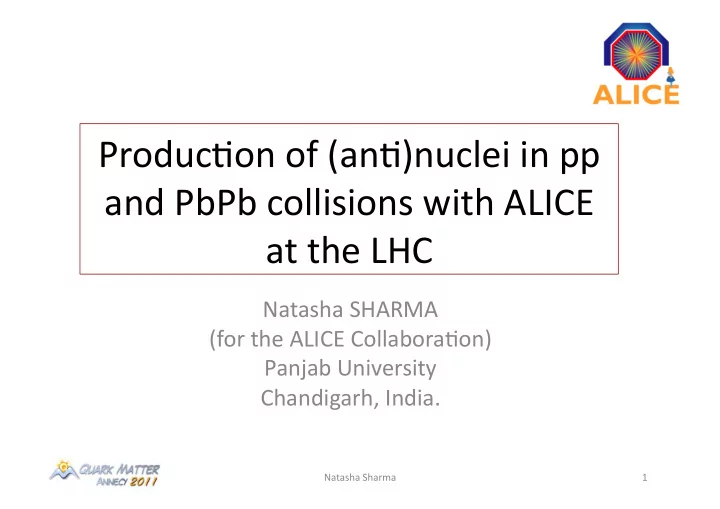

Produc'on of (an')nuclei in pp and PbPb collisions with ALICE at the LHC Natasha SHARMA (for the ALICE Collabora'on) Panjab University Chandigarh, India. Natasha Sharma 1
Outline Par'cle iden'fica'on technique in ALICE Raw yields and spectra for (an')nuclei An'‐alpha and an'‐hypertriton in ALICE Summary and outlook Natasha Sharma 2
Par'cle iden'fica'on PbPb (√s NN = 2.76 TeV) pp (√s = 7 TeV) Θ neg. particles 2.2 million nuclear collisions Natasha Sharma 3
Raw yields and background rejec'on ‐ Nuclei can also be produced due to interac'on with material _ PbPb @ 2.76 TeV d ‐ Compared the DCA of nuclei and an'‐nuclei to es'mate the background contribu'on in the nuclei d ‐ Final counts are taken as raw yields Natasha Sharma 4
Raw spectra: an'‐d & an'‐ 3 He PbPb (√s NN = 2.76 TeV) pp (√s = 7 TeV) Only sta's'cal errors Natasha Sharma 5
An'‐alpha and nuclei‐ra'o Ra'os of an'‐nuclei to nuclei : An'‐alpha iden'fica'on : : __ Four candidates of 4 He are found in the PbPb collisions at √s NN = 2.76 TeV (red points). Natasha Sharma 6
An'‐hypertriton reconstruc'on mass Natasha Sharma 7
Summary and Outlook Summary: ALICE is an excellent detector to study the produc'on of nuclei and an'‐ nuclei We have extracted d‐dbar, t‐tbar, 3 He‐an' 3 He raw spectra in pp @ 7 TeV and PbPb @ 2.76 TeV An'‐alpha and an'‐hypertriton signals are observed with the present sta's'cs in PbPb collisions Outlook: • Comparison of spectra in pp and PbPb collisions (yields, slopes, radial flow). • Comparison of par'cle ra'os with thermal model predic'ons and coalescence expecta'ons. Natasha Sharma 8
Recommend
More recommend